Power’s out yet again at my house (though not for the last reason nor because of our weird wiring: this time it’s for tree trimming), so here I am in my favourite coworking-friendly local cafe with The Signal And The Noise (which I’ve talked about before) in my ears and a whole lot of sprint planning at my fingertips.
Tag: telecommuting
Out as Poly at Work
During one of the periods today that Facebook wasn’t down, a friend who makes use of the platform shared a Facebook post with me, which read:
Has anyone informed work/colleagues about being ENM and how was it received?
I’ve informed a few colleagues but I am considering informing my team as part of my Team Champion and EDI role.
…
I’ve been “out” at every one of the employers1 since I entered into my first open/nonmonogamous relationship a couple of decades ago.
I didn’t do so immediately: in fact, I waited almost until the point that coming out was an academic necessity! The point at which it was only a matter of time before somebody thought they’d caught us “cheating”… or else because I didn’t want to have to lie to coworkers about e.g. from whom a romantic gift might have come.

Here’s how it went to be “out” at each of the three full-time jobs I’ve held over that period:
SmartData
We lived and worked in and around a small town, and in our small tight-knit team we all had a reasonable handle on what was going on in one another’s personal lives. By the time I was actively in a relationship with Ruth (while still in a relationship with Claire, whom all my coworkers had met at e.g. office parties and the like), it just seemed prudent to mention it, as well as being honest and transparent.

It went fine. And it made Monday watercooler conversations about “who what I did at the weekend” simpler. Being a small team sharing a single open-plan office meant that I
was able to mention my relationship status to literally the entire company at once, and everybody took it with a shrug of noncommittal acceptance.
The Bodleian Libraries
The Bodleian Libraries was a much bigger beast, and in turn a part of the massive University of Oxford. It was big enough to have a “LGBT+ Staff” network within its Equality and Diversity unit, within which – because of cultural intersections2 – I was able to meet a handful of other poly folk at the University.

I mentioned very early on – as soon as it came up organically – the structure of the relationship I was in, and everybody was cool (or failing that, at least professional) about it. Curious coworkers asked carefully-crafted questions, and before long (and following my lead) my curious lifestyle choices were as valid a topic for light-hearted jokes as anything else in that fun and gossipy office.
And again: it paid-off pragmatically, especially when I took parental leave after the birth of each of our two kids3.
It also helped defuse a situation when I was spotted by a more-distant coworker on my way back from a lunchtime date with a lover who wasn’t Ruth, and my confused colleague introduced herself to the woman that she assumed must’ve been the partner she’d heard about. When I explained that no, this is a different person I’m seeing my colleague seemed taken aback, and I was glad to be able to call on a passing coworker who knew me better to back me up in my assertion that no, this wasn’t just me trying to lie to cover some illicit work affair! Work allies are useful.
Automattic
I’ve been with Automattic for four and a half years now, and this time around I went one step further in telling potential teammates about my relationship structure by mentioning it in my “Howdymattic” video – a video introduction new starters are encouraged to record to say hi to the rest of the company4.

A convenient side-effect of this early coming-out was that I found myself immediately inducted into the “polymatticians” group – a minor diversity group within Automattic, comprising a massive 1.2% of the company, who openly identify as engaging in nonmonogamous relationships5!
That was eye-opening. Not only does Automattic have a stack of the regular inclusivity groups you might expect from a big tech company (queer, Black, women, trans, neurodiverse) and a handful of the less-common ones (over-40s, cancer survivors, nondrinkers, veterans), they’ve also got a private group for those of us who happen to be both Automatticians and in (or inclined towards) polyamorous relationships. Mind blown.
My relationship structure’s been… quietly and professionally accepted. It doesn’t really come up (why would it? in a distributed company it has even less-impact on anything than it did in my previous non-distributed roles)… outside of the “polymatticians” private space.
In summary: I can recommend being “out” at work. So long as you’d feel professionally safe to do so: relationship structure isn’t necessarily a protected characteristic (it’s complicated), and even if it were you might be careful about mentioning it in some environments. It’s great to have the transparency to not have to watch your words when a coworker asks about “your partner”. Plus being free to be emotionally honest at work is just good for your mental wellbeing, in my opinion! If you trust your coworkers, be honest with them. If you don’t… perhaps you need to start looking for a better job?
Footnotes
1 I’m not counting my freelance work during any of those periods, although I’ve been pretty transparent with them too.
2 Let’s be clear: most queer folks, just like most straight folks, seem to be similarly-inclined towards monogamy. But ethnical non-monogamy in various forms seems to represent a larger minority within queer communities than outside them. There’s all kinds of possible reasons for this, and smarter people than me have written about them, but personally I’m of the opinion that, for many, it stems from the fact that by the time you’re societally-forced to critically examine your relationships, you might as well go the extra mile and decide whether your relationship structure is right for you too. In other words: I suspect that cis hetro folks would probably have a proportional parity of polyamory if they weren’t saturated with media and cultural role models that show them what their relationship “should” look like.
3 Unwilling to lie, I made absolutely clear that I was neither the father of either of them nor the husband of their mother (among other reasons, the law prohibits Ruth from marrying me on account of being married to JTA), but pointed out that my contract merely stipulated that I was the partner of a birth parent, which was something I’d made completely clear since I first started working there. I’m not sure if I was just rubber-stamped through the University’s leave process as a matter of course or if they took a deeper look at me and figured “yeah, we’re not going to risk picking a legal fight with that guy”, but I got my leave granted.
4 If you enjoyed my “Howdymattic”, you’ll probably also love the outtakes.
5 There are dozens of us! Dozens!
Taking a Jackbox Zoom Party to the Next Level
A love a good Jackbox Game. There’s nothing quite like sitting around the living room playing Drawful, Champ’d Up, Job Job, Trivia Murder Party, or Patently Stupid. But nowadays getting together in the same place isn’t as easy as it used to be, and as often as not I find my Jackbox gaming with friends or coworkers takes place over Zoom, Around, Google Meet or Discord.
There’s lots of guides to doing this – even an official one! – but they all miss a few pro tips that I think can turn a good party into a great party. Get all of this set up before your guests are due to arrive to make yourself look like a super-prepared digital party master.
1. Use two computers!
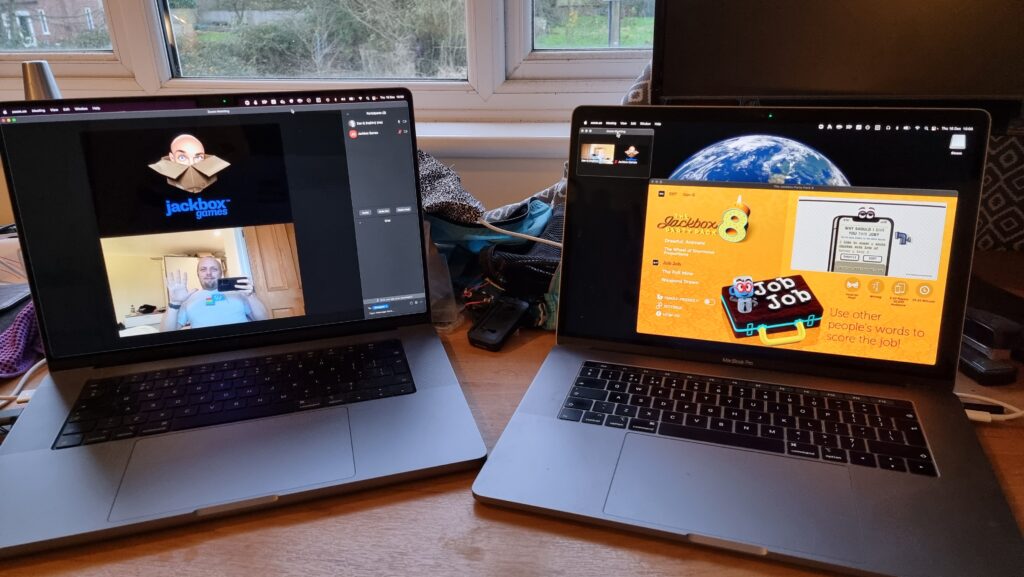
Using one computer for your video call and a second one to host the game (in addition to the device you’re using to play the games, which could be your phone) is really helpful for several reasons:
- You can keep your video chat full-screen without the game window getting in the way, letting you spend more time focussed on your friends.
- Your view of the main screen can be through the same screen-share that everybody else sees, helping you diagnose problems. It also means you experience similar video lag to everybody else, keeping things fair!
- You can shunt the second computer into a breakout room, giving your guests the freedom to hop in and out of a “social” space and a “gaming” space at will. (You can even set up further computers and have multiple different “game rooms” running at the same time!)
2. Check the volume

Connect some headphones to the computer that’s running the game (or set up a virtual audio output device if you’re feeling more technical). This means you can still have the game play sounds and transmit them over Zoom, but you’ll only hear the sounds that come through the screen share, not the sounds that come through the second computer too.
That’s helpful, because (a) it means you don’t get feedback or have to put up with an echo at your end, and (b) it means you’ll be hearing the game exactly the same as your guests hear it, allowing you to easily tweak the volume to a level that allows for conversation over it.
3. Optimise the game settings
Jackbox games were designed first and foremost for sofa gaming, and playing with friends over the Internet benefits from a couple of changes to the default settings.
Sometimes the settings can be found in the main menu of a party pack, and sometimes they’re buried in the game itself, so do your research and know your way around before your party starts.
Turn the volume down, especially the volume of the music, so you can have a conversation over the game. I’d also recommend disabling Full-screen Mode: this reduces the resolution of the game, meaning there’s less data for your video-conferencing software to stream, and makes it easier to set up screen sharing without switching back and forth between your applications (see below).

Turning on the Motion Sensitivity or Reduce Background Animations option if your game has it means there’ll be less movement in the background of the game. This can really help with the
video compression used in videoconferencing software, meaning players on lower-speed connections are less-likely to experience lag or “blockiness” in busy scenes.
It’s worth considering turning Subtitles on so that guests can work out what word they missed (which for the trivia games can be a big deal). Depending on your group, Extended Timers is worth considering too: the lag introduced by videoconferencing can frustrate players who submit answers at the last second only to discover that – after transmission delays – they missed the window! Extended Timers don’t solve that, but they do mean that such players are less-likely to end up waiting to the last second in the first place.

Finally: unless the vast majority or all of your guests are in the USA, you might like to flip the Filter US-Centric Content
switch so that you don’t get a bunch of people scratching their heads over a cultural reference that they just don’t get.
By the way, you can use your cursor keys and enter to operate Jackbox games menus, which is usually easier than fiddling with a mouse.
4. Optimise Zoom’s settings
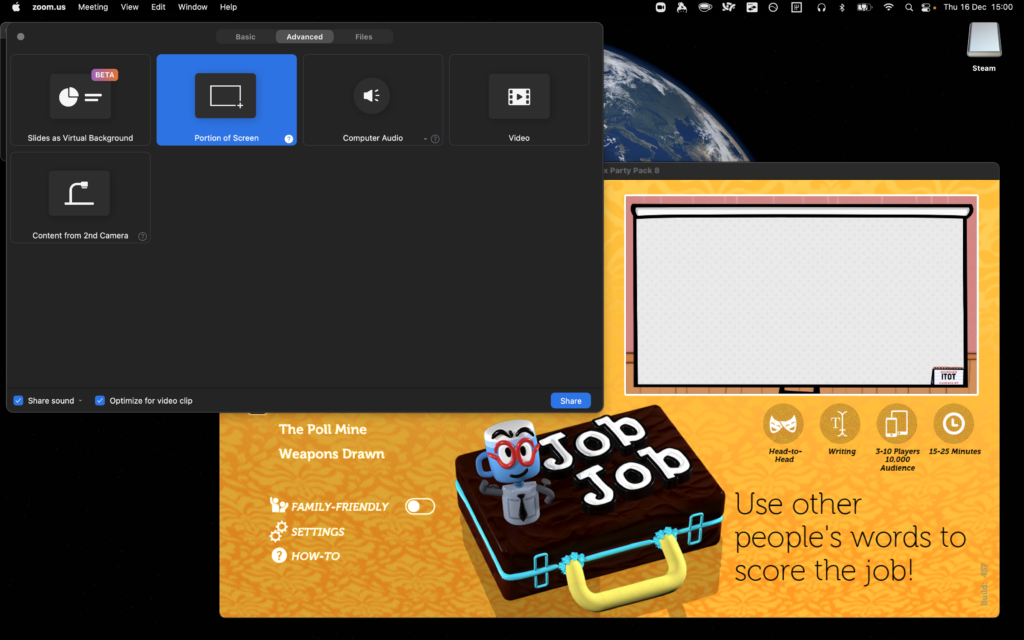
Whatever videoconferencing platform you’re using, the settings for screen sharing are usually broadly similar. I suggest:
- Make sure you’ve ticked “Share sound” or a similar setting that broadcasts the game’s audio: in some games, this is crucial; in others, it’s nice-to-have. Use your other computer to test how it sounds and tweak the volume accordingly.
- Check “Optimize for video clip”; this hints to your videoconferencing software that all parts of the content could be moving at once so it can use the same kind of codec it would for sending video of your face. The alternative assumes that most of the screen will stay static (because it’s the desktop, the background of your slides, or whatever), which works better with a different kind of codec.
- Use “Portion of Screen” sharing rather than selecting the application. This ensures that you can select just the parts of the application that have content in, and not “black bars”, window chrome and the like, which looks more-professional as well as sending less data over the connection.
- If your platform allows it, consider making the mouse cursor invisible in the shared content: this means that you won’t end up with an annoying cursor sitting in the middle of the screen and getting in the way of text, and makes menu operation look slicker if you end up using the mouse instead of the keyboard for some reason.
Don’t forget to shut down any software that might “pop up” notifications: chat applications, your email client, etc.: the last thing you want is somebody to send you a naughty picture over WhatsApp and the desktop client to show it to everybody else in your party!
Creed Cult-ure
My employer, Automattic, has a creed. Right now it reads:
I will never stop learning. I won’t just work on things that are assigned to me. I know there’s no such thing as a status quo. I will build our business sustainably through passionate and loyal customers. I will never pass up an opportunity to help out a colleague, and I’ll remember the days before I knew everything. I am more motivated by impact than money, and I know that Open Source is one of the most powerful ideas of our generation. I will communicate as much as possible, because it’s the oxygen of a distributed company. I am in a marathon, not a sprint, and no matter how far away the goal is, the only way to get there is by putting one foot in front of another every day. Given time, there is no problem that’s insurmountable.
Lots of companies have something like this, even if it falls short of a “creed”. It could be a “vision”, or a set of “values”, or something in that line.
Of course, sometimes that just means they’ve strung three clichéd words together because they think it looks good under their company logo, and they might as well have picked any equally-meaningless words.
- respect
- integrity
- teamwork
But while most companies (and their staff) might pay lip service to their beliefs, Automattic’s one of few that seems to actually live it. And not in an awkward, shoehorned-in way: people here actually believe this stuff.
By way of example:

We’ve got a bot that, among other things, pairs up people from across the company for virtual “watercooler chat”/”coffee dates”/etc. It’s cool: I pair-up with random colleagues in my division, or the whole company, or fellow queermatticians… and collectively these provide me a half-hour hangout about once a week. It’s a great way to experience the diversity of culture, background and interests of your colleagues, as well as being a useful way to foster idea-sharing and “watercooler effect” serendipity.
For the last six months or so, I’ve been bringing a particular question to almost every random-chat I’ve been paired into:
What part of the Automattic creed resonates most-strongly for you right now?

I volunteer my own answer first. It’s varied over time. Often I’m most-attached to “I will never stop learning.” Other times I connect best to “I will communicate as much as possible…” or “I am in a marathon, not a sprint…”. Lately I’ve felt a particular engagement with “I will never pass up the opportunity to help a colleague…”.
It varies for other people too. But every single person I’ve asked this question has been able to answer it. And they’ve been able to answer it confidently and with justifications for or examples of their choice.
Have you ever worked anywhere before where seemingly all your coworkers profess a genuine belief in the corporate creed? Like, enough that some of them get it tattooed onto their bodies. Unless you’ve been brainwashed by a cult, the answer is probably no.

Why are Automatticians like that?
For some folks, of course, the creed is descriptive rather than prescriptive. Regarding its initial creation, Matt says that “as a hack to introduce new folks to our culture, we put a beta Automattic Creed, basically a statement of things important to us, written in the first person.”
But this alone isn’t an explanation, because back then there were only around a hundred people in the company: nowadays there are over 1,500. So how can the creed continue to be such a pervasive influence? Or to put it another way: why are Automatticians… like that?
- Do we simply attract like-minded individuals? The creed is highly visible and cross-referenced by our recruitment pages, so it wouldn’t be entirely surprising.
- Maybe we filter for people who are ideologically-compatible with the creed? Insofar as the qualities it describes are essential to integrating into our corporate culture, yes: our recruitment process does a great job of testing for those qualities.
- Perhaps we converge on these values as a result of our experience as Automatticians? Once you’re in, you’re indoctrinated into the tenets of the creed and internalise its ideas.
- Or perhaps it’s a combination of the three, in some ratio or another. (What’s the ratio?)
I’ve been here 1⅔ years and don’t know the answer yet. But I’ll tell you this: it’s inspiring to be part of a team that really seem to believe in what they do.
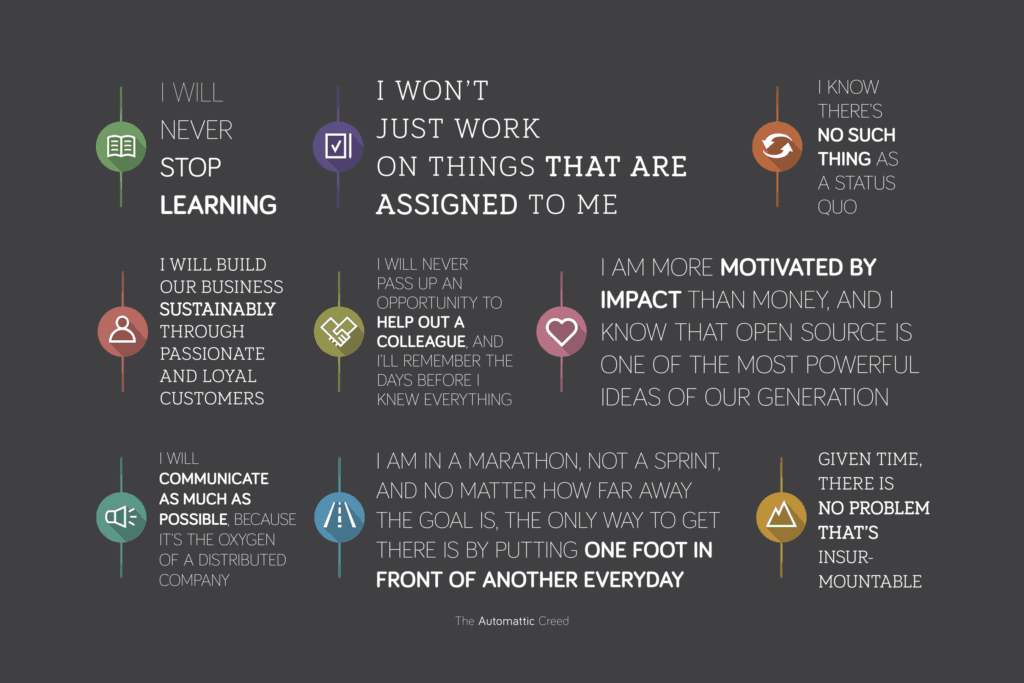
Incidentally: if the creed speaks to you too, you might like to look at some of the many open positions! I promise we’re not actually a cult.
Plus we’ve been doing “work anywhere” for longer than almost anybody else and we’re really, really good at it.
If you enjoyed this, you might also like other blog posts about my time with Automattic: the recruitment process, accepting an offer, my induction, and the experience of lockdown in a distributed company, among others.
Future Challenges for Remote Working
When the COVID-19 lockdown forced many offices to close and their staff to work remotely, some of us saw what was unfolding as an… opportunity in disguise. Instead of the slow-but-steady decentralisation of work that’s very slowly become possible (technically, administratively, and politically) over the last 50 years, suddenly a torrent of people were discovering that remote working can work.

The Future is Now
As much as I hate to be part of the “where’s my flying car?” brigade, I wrote ten years ago about my dissatisfaction that remote working wasn’t yet commonplace, let alone mainstream. I recalled a book I’d read as a child in the 1980s that promised a then-future 2020 of:
- near-universal automation of manual labour as machines become capable of an increasing diversity of human endeavours (we’re getting there, but slowly),
- a three- or four-day work week becoming typical as efficiency improvements are reinvested in the interests of humans rather than of corporations (we might have lost sight of that goal along the way, although there’s been some fresh interest in it lately), and
- widespread “teleworking”/”telecommuting”, as white-collar sectors grow and improvements in computing and telecommunications facilitate the “anywhere office”
Of those three dreams, the third soon seemed like it would become the most-immediate. Revolutionary advances in mobile telephony, miniaturisation of computers, and broadband networking ran way ahead of the developments in AI that might precipitate the first dream… or the sociological shift required for the second. But still… progress was slow.
At eight years old, I genuinely believed that most of my working life would be spent… wherever I happened to be. So far, most of my working life has been spent in an office, despite personally working quite hard for that not to be the case!

I started at Automattic six months ago, an entirely distributed company. And so when friends and colleagues found themselves required to work remotely by the lockdown they came in droves to me for advice about how to do it! I was, of course, happy to help where I could: questions often covered running meetings and projects, maintaining morale, measuring output, and facilitating communication… and usually I think I gave good answers. Sometimes, though, the answer was “If you’re going to make that change, you’re going to need a cultural shift and some infrastructure investment first.” Y’know: “Don’t start from here.” If you received that advice from me: sorry!
(Incidentally, if you have a question I haven’t answered yet, try these clever people first for even better answers!)
More-recently, I was excited to see that many companies have adopted this “new normal” not as a temporary measure, but as a possible shape of things to come. Facebook, Twitter, Shopify, Square, and Spotify have all announced that they’re going to permit or encourage remote work as standard, even after the crisis is over.
Obviously tech companies are leading the way, here: not only are they most-likely to have the infrastructure and culture already in place to support this kind of shift. Also, they’re often competing for the same pool of talent and need to be seen as at-least as progressive as their direct rivals. Matt Mullenweg observes that:
What’s going to be newsworthy by the end of the year is not technology companies saying they’re embracing distributed work, but those that aren’t.
…some employers trapped in the past will force people to go to offices, but the illusion that the office was about work will be shattered forever, and companies that hold on to that legacy will be replaced by companies who embrace the antifragile nature of distributed organizations.
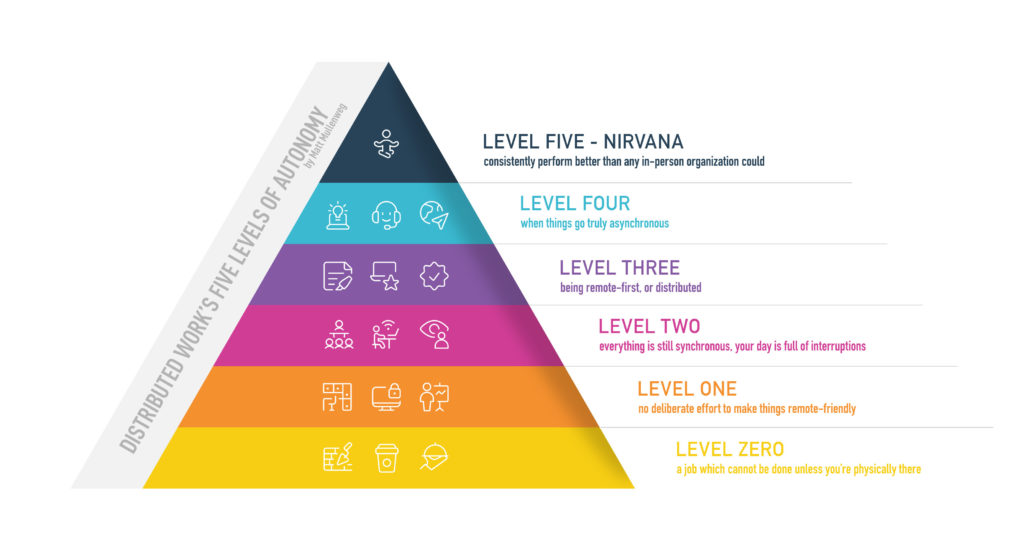
Tomorrow’s Challenges
We’re all acutely familiar with the challenges companies are faced with today as they adapt to a remote-first environment. I’m more interested in the challenges that they might face in the future, as they attempt to continue to use a distributed workforce as the pandemic recedes. It’s easy to make the mistake of assuming that what many people are doing today is a rehearsal for the future of work, but the future will look different.
Some people, of course, prefer to spend some or all of their work hours in an office environment. Of the companies that went remote-first during the lockdown and now plan to stay that way indefinitely, some will lose employees who preferred the “old way”. For this and other reasons, some companies will retain their offices and go remote-optional, allowing flexible teleworking, and this has it’s own pitfalls:
- Some remote-optional offices have an inherent bias towards in-person staff. In some companies with a mixture of in-person and remote staff, remote workers don’t get included in ad-hoc discussions, or don’t become part of the in-person social circles. They get overlooked for projects or promotions, or treated as second-class citizens. It’s easy to do this completely by accident and create a two-tiered system, which can lead to a cascade effect that eventually collapses the “optional” aspect of remote-optional; nowhere was this more visible that in Yahoo!’s backslide against remote-optional working in 2013.
- Some remote-optional offices retain an archaic view on presenteeism and “core hours”. Does the routine you keep really matter? Remote-first working demands that productivity is measured by output, not by attendance, but management-by-attendance is (sadly) easier to implement, and some high-profile organisations favour this lazy but less-effective approach. It’s easy, but ineffective, for a remote-optional company to simply extend hours-counting performance metrics to their remote staff. Instead, allowing your staff (insofar as is possible) to work the hours that suit them as individuals opens up your hiring pool to a huge number of groups whom you might not otherwise reach (like single parents, carers, digital nomads, and international applicants) and helps you to get the best out of every one of them, whether they’re an early bird, a night owl, or somebody who’s most-productive after their siesta!
- Pastoral care doesn’t stop being important after the crisis is over. Many companies that went remote-first for the coronavirus crisis have done an excellent job of being supportive and caring towards their employees (who, of course, are also victims of the crisis: by now, is there anybody whose life hasn’t been impacted?). But when these companies later go remote-optional, it’ll be easy for them to regress to their old patterns. They’ll start monitoring the wellbeing only of those right in front of them. Remote working is already challenging, but it can be made much harder if your company culture makes it hard to take a sick day, seek support on a HR issue, or make small-talk with a colleague.

These are challenges specifically for companies that go permanently remote-optional following a period of remote-first during the coronavirus crisis.
Towards a Post-Lockdown Remote-Optional Workplace
How you face those challenges will vary for every company and industry, but it seems to me that there are five lessons a company can learn as it adapts to remote-optional work in a post-lockdown world:
- Measure impact, not input. You can’t effectively manage a remote team by headcount or closely tracking hours; you need to track outputs (what is produced), not inputs (person-hours). If your outputs aren’t measurable, make them measurable, to paraphrase probably-not-Galileo. Find metrics you can work with and rely on, keep them transparent and open, and re-evaluate often. Use the same metrics for in-office and remote workers.
- Level the playing field. Learn to spot the biases you create. Do the in-person attendees do all the talking at your semi-remote meetings? Do your remote workers have to “call in” to access information only stored on-site (including in individual’s heads)? When they’re small, these biases have a huge impact on productivity and morale. If they get big, they collapse your remote-optional environment.
- Always think bigger. You’re already committing to a shakeup, dragging your company from the 2020 of the real world into the 2020 we once dreamed of. Can you go further? Can you let your staff pick their own hours? Or workdays? Can your staff work in other countries? Can you switch some of your synchronous communications channels (e.g. meetings) into asynchronous information streams (chat, blogs, etc.)? Which of your telecommunications tools serve you, and which do you serve?
- Remember the human. Your remote workers aren’t faceless (pantsless) interchangeable components in your corporate machine. Foster interpersonal relationships and don’t let technology sever the interpersonal links between your staff. Encourage and facilitate (optional, but awesome) opportunities for networking and connection. Don’t forget to get together in-person sometimes: we’re a pack animal, and we form tribes more-easily when we can see one another.
- Support people through the change. Remote working requires a particular skillset; provide tools to help your staff adapt to it. Make training and development options available to in-office staff too: encourage as flexible a working environment as your industry permits. Succeed, and your best staff will pay you back in productivity and loyalty. Fail, and your best staff will leave you for your competitors.
I’m less-optimistic than Matt that effective distributed working is the inexorable future of work. But out of the ashes of the coronavirus crisis will come its best chance yet, and I know that there’ll be companies who get left behind in the dust. What are you doing to make sure your company isn’t one of them?
Note #16758
180 Tips for Remote Working
This is a repost promoting content originally published elsewhere. See more things Dan's reposted.
I enjoyed many of these (I note that my colleagues at Automattic are behind a significant number of them).
I’m not yet at the point of needing emergency assistance for my distributed working habits, but I’ve definitely passed the pigeon stage…
Working From Home
The phone rings. It’s clear to me by the sound it makes and by the image on it’s display that this is a business call.
“Good morning, SmartData; Dan speaking,” I say.
The caller identifies themselves, and asks to speak to Alex, another SmartData employee. I look to my right to see if Alex is available (presumably if he was, he’d have answered the call before it had been forwarded to me). This is possible because of the two-way webcam feed on the monitor beside me.
“I’m afraid Alex isn’t in yet,” I begin, bringing up my co-worker’s schedule on the screen in front of me, to determine what he’s up to, “He’ll be in at about 10:30 this morning. Can I get him to call you back?”
Not for a second did it occur to the caller that I wasn’t sat right there in the office, looking over at Alex’s chair and a physical calendar. Of course, I’m actually hundreds of miles away, in my study in Oxford. Most of our clients – even those whom I deal with directly – don’t know that I’m no longer based out of SmartData’s marina-side offices. Why would they need to? Just about everything I can do from the office I can do from my own home. Aside from sorting the mail on a morning and taking part in the occasional fire drill, everything I’d regularly do from Aberystwyth I can do from here.
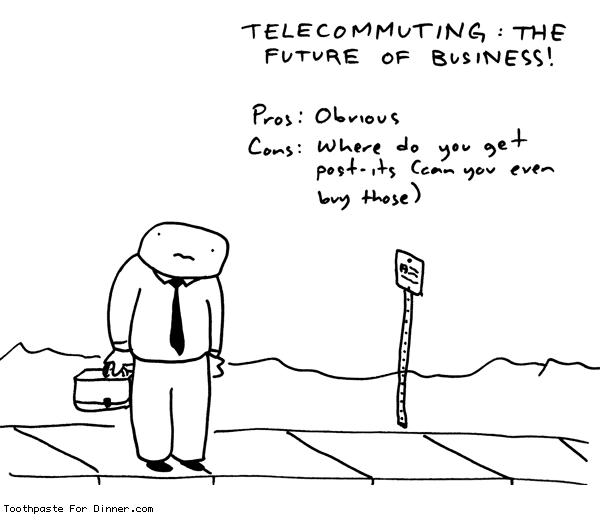
Back when I was young, I remember reading a book once which talked about advances in technology and had wonderful pictures of what life would be like in the future. This wasn’t a
dreamland of silver jumpsuits and jetpacks; everything they talked about in this book was rooted in the trends that we were already beginning to see. Published in the early 80s, it
predicted a microcomputer in every home and portable communicators that everybody would have that could be used to send messages or talk to anybody else, all before the 21st century.
Give or take, that’s all come to pass. I forget what the title of the book was, but I remember enjoying it as a child because it seemed so believable, so real. I guess it inspired a
hopeful futurism in me.
But it also made another prediction: that with this rise in telecommunications technologies and modern microcomputers (remember when we still routinely called them that?), we’d see a greap leap in the scope for teleworking: office workers no longer going to a place of work, but remotely “dialling in” to a server farm in a distant telecentre. Later, it predicted, with advances in robotics, specialist workers like surgeons would be able to operate remotely too: eventually, through mechanisation of factories, even manual labourers would begun to be replaced by work-at-home operators sat behind dumb terminals.
To play on a cliché: where’s my damn flying car?
By now, I thought that about a quarter of us would be working from home full-time or most of the time, with many more – especially in my field, where technology comes naturally – working from home occasionally. Instead, what have we got? Somewhere in the region of one in fifty, and that includes the idiots who’ve fallen for the “Make £££ working from home” scams that do the rounds every once in a while and haven’t yet realised that they’re not going to make any £, let alone £££.
At first, I thought that this was due to all of the traditionally-cited reasons: companies that don’t trust their employees, managers who can’t think about results-based assessment rather than presence-based assessment, old-school thinking, and not wanting to be accused of favouritism by allowing some parts of their work force to telework while others can’t. In some parts of the world, and some fields, we’ve actually seen a decrease in teleworking over recent years: what’s all that about?
I’m sure that the concerns listed above are still critical factors for many companies, but I’ve realised that there could be another, more-recent fear that’s now preventing the uptake of teleworking in many companies. That fear is one that affects everybody – both the teleworkers and their comrades in the offices, and it’s something that more and more managers are becoming aware of: the fear of outsourcing.
After all, if a company’s employees can do their work from home, then they can do it from anywhere. With a little extra work on technical infrastructure and a liberal attitude to meetings, the managers can work from anywhere, too. So why stop at working from home? Once you’ve demonstrated that your area of work can be done without coming in to the office, then you’re half-way to demonstrating that it can be done from Mumbai or Chennai, for a fraction of the price… and that’s something that’s a growing fear for many kinds of technical workers in the Western world.
Our offices are a security blanket: we’re clinging on to them because we like to pretend that they’ll protect us; that they’re something special and magical that we can offer our clients that the “New World” call centres and software houses in India and China can’t offer them. I’m not sure that a security blanket that allows us to say “we have a local presence” will mean as much in ten years time as it does today.
In the meantime, I’m still enjoying working from home. It’s a little lonely, sometimes – on days when JTA isn’t around, which are going to become more common when he starts his new job – but the instant messenger and Internet telephony tools we use make it feel a little like I’m actually in the office, and that’s a pretty good trade-off in exchange for being able to turn up at work in my underwear, if I like.


